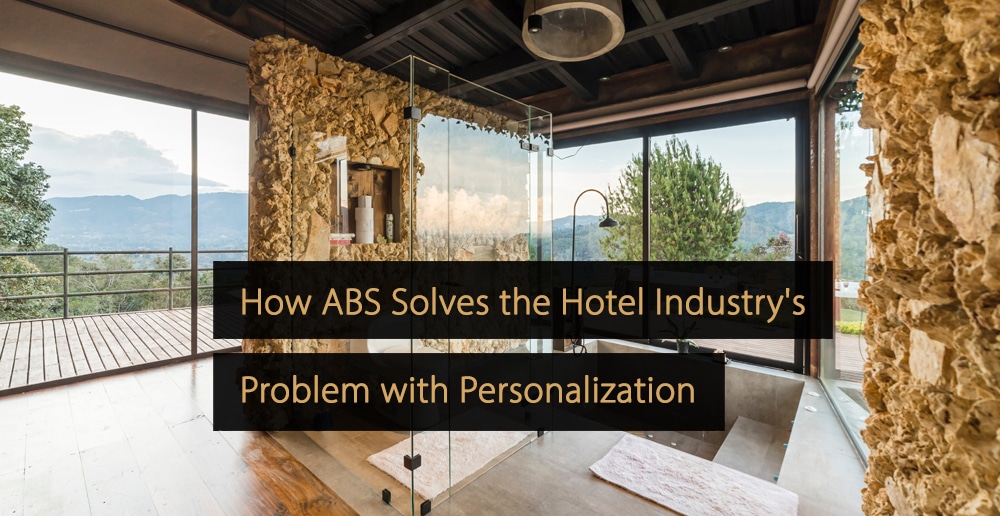Als Verbraucher sind wir täglich von extremer Personalisierung umgeben. Ob KI-gesteuerte Produktempfehlungen, Optionen bei der Buchung eines Flugtickets oder sogar das Hinzufügen von zusätzlicher Peperoni auf einer Pizza – Verbraucher sind bei ihren Online-Einkaufserlebnissen häufig Personalisierungsmechanismen ausgesetzt.
Verbraucher erwarten Personalisierung
Verbraucher erwarten Personalisierung mittlerweile als Standardfunktion. Überwältigende 70 % der Befragten sagen, dass sie ausschließlich bei Marken einkaufen, die sie persönlich verstehen. Und für Unternehmen, die in Personalisierung investieren, kann sich dieser Aufwand durchaus auszahlen und zu einem Umsatzwachstum führen, das 10-30 % über herkömmliche Merchandising-Methoden hinausgeht.
Bei Hotels hingegen ist die Zimmerbuchung ein passiver Top-down-Prozess, bei dem es kaum oder gar keinen Raum für Personalisierung gibt. Der gesamte Prozess besteht aus drei linearen Schritten.
- Der Gast wählt ein Hotel und wählt Buchungsdaten
- Sie filtern die Ergebnisse nach Zimmertyp oder Preis (oft einschließlich Paketen)
- Sie wählen "Buch" und geben Sie eine Kreditkarte ein.
Fertig. Das Problem bei diesem Weg zum Kauf ist, dass die Tiefe und Breite der Personalisierungsmöglichkeiten auf die Variationen des Zimmertyps beschränkt sind … vielleicht mit oder ohne Frühstück.
Schlimmer noch: Alle Zimmervarianten (z. B. ein oberes Stockwerk, in der Nähe des Aufzugs, Blick auf den Pool usw.) werden in den „Blob“ der Zimmerkategorie eingeordnet. Bis auf die Bettenart sehen jetzt alle Zimmertypen gleich aus.
„Bei der heutigen Hotelzimmerverteilung muss der Gast die Beschreibungen der einzelnen Zimmerkategorien durchlesen, um die Kombination der Merkmale oder Attribute der einzelnen Kategorien besser zu verstehen und dann eine einheitliche Kaufentscheidung zu treffen“, sagt Pierre Boettner, Head of Product und Mitgründer, ROOMDEX. Das führt oft dazu, dass die Leute die niedrigste Kategorie buchen. „Ein Hotel mit Zimmern zu finden, die zum Gast passen und preislich in seinem Rahmen liegen, kann viele individuelle Besuche vor Ort erfordern.“
Merchandising neu denken
Amazon oder Netflix können Ihnen andere Produkte vorschlagen, die Ihnen gefallen könnten, da sie viele „SKUs“ haben. Ein normales Hotel mittlerer Größe hat normalerweise 4 Zimmertypen, sodass Sie theoretisch von etwa 200 Zimmern nur 4 Produkte verkaufen können.
Aber bei näherer Betrachtung haben Hotels mehr zu bieten als 4 Produkte. Nehmen wir zum Beispiel an, dass es unter diesen 200 Zimmern 25 einzigartige Merkmale oder Eigenschaften gibt, wie z. B. in der Nähe des Aufzugs, im obersten Stockwerk, im Erdgeschoss, Einzelzimmer, Doppelzimmer, hinter dem Haus, Balkon, Meerblick usw., und plötzlich, mit diesen Kombinationen. In diesem Fall hat ein Hotel viel mehr Produkte zu bieten. Gäste sind nicht mehr auf ein "Menü" Sie können nicht zwischen verschiedenen Zimmertypen wählen, sondern aus einer Vielzahl von Optionen wählen und Ihren Aufenthalt Ihren Wünschen entsprechend personalisieren.
Darüber hinaus ist bei den heutigen Buchungssystemen „der endgültige Zimmerpreis, der dem Gast angezeigt wird, fast nie die wissenschaftliche Summe der intrinsischen Werte der einzelnen Zimmerattribute, sondern bestenfalls eine Schätzung, eine Annäherung, die durch volatile Kennzahlen wie Gesamtbelegungsrate, Vergleichsgruppe und Abholgeschwindigkeit verzerrt wird“, sagt der Chefevangelist von IDeaS Klaus Kohlmayr. Im Wesentlichen begrenzen Zimmertypen die Personalisierung.
Geben Sie dem Kunden eine Wahl mit Attribute-based Selling (ABS)
Der attributbasierte Verkauf kann das Personalisierungsproblem der Hotelbranche lösen. ABS kann Kundenbedürfnisse und Hotelausstattung besser aufeinander abstimmen, indem es Zimmertypen entbündelt. Anstatt die Gäste auf voreingestellte Zimmertypen und Preispläne zu beschränken, können sie bei ABS auswählen, für welche Zimmerattribute sie zu zahlen bereit sind, um ihr perfektes Zimmer zusammenzustellen.
Gäste können sich zu Beginn des Buchungsvorgangs für ihre bevorzugten Funktionen entscheiden, wobei jedes Attribut einen zusätzlichen Preis zum Basiszimmerpreis hinzufügt. Der Prozess macht es für den Gast viel einfacher, seinen Hotelaufenthalt von Anfang an individuell zu gestalten und zu personalisieren, während er gleichzeitig die Kontrolle darüber behält, was er letztendlich bezahlen wird.
Der Wert und die Auswirkungen dieser Wahl für den Gast sind erheblich. Mit ABS sprechen Hotels Gäste nicht nur mit Versprechen und Erwartungen an, sondern liefern das „Echte“. „[ABS] macht den Kaufprozess nicht nur einfacher und die Preisgestaltung transparenter, sondern vermeidet auch falsche Wahlparadoxien und erhöht sofort die Zufriedenheit“, fuhr Pierre Boettner fort.
Darüber hinaus macht ABS für Hoteliers die Zimmertypen weniger wichtig und hilft ihnen, Überbuchungen bestimmter Kategorien zu vermeiden, was zu einem ausgeglichenen Hotelbetrieb beiträgt. Aber es steigert auch den Umsatz. Beim traditionellen Hotelbuchungsprozess steigen die Zimmerpreise, wenn das Angebot an bestimmten Zimmern sinkt, aber mit ABS steigen die Attributpreise, wenn das Angebot an bestimmten Attributen sinkt. Mit ABS wäre es möglich, dass ein Standardzimmerpreis auf den Preis einer höherwertigen Zimmerkategorie steigt, wenn ein Gast weitere Attribute hinzufügt.
Steigern Sie Ihren Umsatz und die Zufriedenheit Ihrer Gäste
Jedes Hotel kann seinen Gästen Zimmerattribute anbieten – diese müssen entbündelt werden. Dafür müssen drei Dinge passieren. Erstens müssen die Kunden ihre Reise personalisieren wollen. Wie bereits erwähnt, wird das einfach sein. Zweitens müssen technologische Fortschritte gemacht werden, um ein attributbasiertes Einkaufen zu ermöglichen.
Dies ist auch viel näher an der Realität als je zuvor, mit Unternehmen wie RAUMDEX den ABS-Code zu knacken; schließlich braucht es Weitsicht und Willen von den Hoteliers. Hoteliers haben die Möglichkeit, ihre Räumlichkeiten neu zu überdenken und den Umsatz aus der Zimmerausstattung zu steigern und gleichzeitig die Personalisierung zu bieten, die die Gäste erwarten. Während viele zufrieden damit sind, der Masse zu folgen, werden die Marktführer in Ihrem Wettbewerbsumfeld zweifellos die richtigen Investitionen tätigen, um sich einen Vorsprung zu verschaffen.
Weitere Tipps zum Wachstum Ihres Unternehmens
Revfine.com ist die führende Wissensplattform für die Hotel- und Reisebranche. Fachleute nutzen unsere Erkenntnisse, Strategien und umsetzbaren Tipps, um sich inspirieren zu lassen, den Umsatz zu optimieren, Prozesse zu erneuern und das Kundenerlebnis zu verbessern.Entdecken Sie Expertenratschläge zu Management, Marketing, revenue management, Betrieb, Software und Technologie in unserem speziellen Hotel, Gastfreundschaft, und Reise Tourismus Kategorien.








Leave A Comment